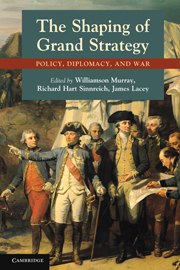Book contents
- Frontmatter
- Contents
- Contributors
- 1 Thoughts on grand strategy
- 2 The grand strategy of the grand siècle: Learning from the wars of Louis XIV
- 3 Strategic culture and the Seven Years' War
- 4 Strategy as character: Bismarck and the Prusso-German question, 1862–1878
- 5 About turn: British strategic transformation from Salisbury to Grey
- 6 British grand strategy, 1933–1942
- 7 Toward a strategy: Creating an American strategy for global war, 1940–1943
- 8 Harry S. Truman and the forming of American grand strategy in the Cold War, 1945–1953
- 9 Patterns of grand strategy
- Index
9 - Patterns of grand strategy
Published online by Cambridge University Press: 05 June 2012
- Frontmatter
- Contents
- Contributors
- 1 Thoughts on grand strategy
- 2 The grand strategy of the grand siècle: Learning from the wars of Louis XIV
- 3 Strategic culture and the Seven Years' War
- 4 Strategy as character: Bismarck and the Prusso-German question, 1862–1878
- 5 About turn: British strategic transformation from Salisbury to Grey
- 6 British grand strategy, 1933–1942
- 7 Toward a strategy: Creating an American strategy for global war, 1940–1943
- 8 Harry S. Truman and the forming of American grand strategy in the Cold War, 1945–1953
- 9 Patterns of grand strategy
- Index
Summary
Readers who have navigated all seven of the cases examined in the preceding pages might be pardoned for doubting whether grand strategy, in the sense of the consistent execution over time of a preconceived strategic design, is even possible, let alone likely. Certainly none of those cases reveal such a pattern. “In fact,” as Professor Murray notes in his introduction, “those who have developed successful grand strategies in the past have been very much the exception…a strategic framework, much less a grand strategy, has rarely guided those responsible for the long-term survival” of the state.
Instead, on the evidence of our cases, grand strategy is much more likely to be imputed retrospectively by admirers and critics than developed and applied self-consciously by the statesmen whom they typically credit or blame. At least two of the statesmen examined in the preceding essays explicitly acknowledged that reality in strikingly similar analogies: Britain's Robert Lord Salisbury likened the business of managing foreign policy to “float[ing] lazily downstream, occasionally putting out a diplomatic boat-hook to avoid collisions,” while his great Prussian contemporary, Prince Otto von Bismarck, similarly insisted that “man cannot create the current of events. He can only float with it and steer.”
Both certainly were too modest. But history confirms that even in war, in which its explicit formulation is most likely, grand strategy almost never will be executed as conceived. The fortunes of war are too chancy and adversaries too unpredictable to underwrite such prolonged consistency.
- Type
- Chapter
- Information
- The Shaping of Grand StrategyPolicy, Diplomacy, and War, pp. 254 - 270Publisher: Cambridge University PressPrint publication year: 2011
- 3
- Cited by



